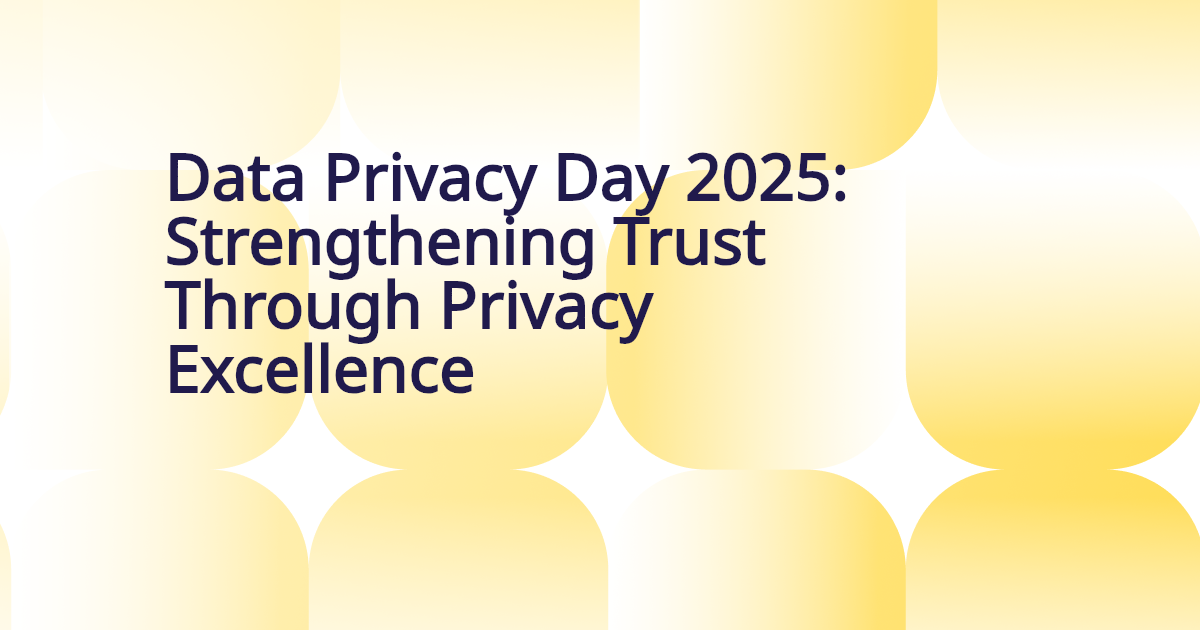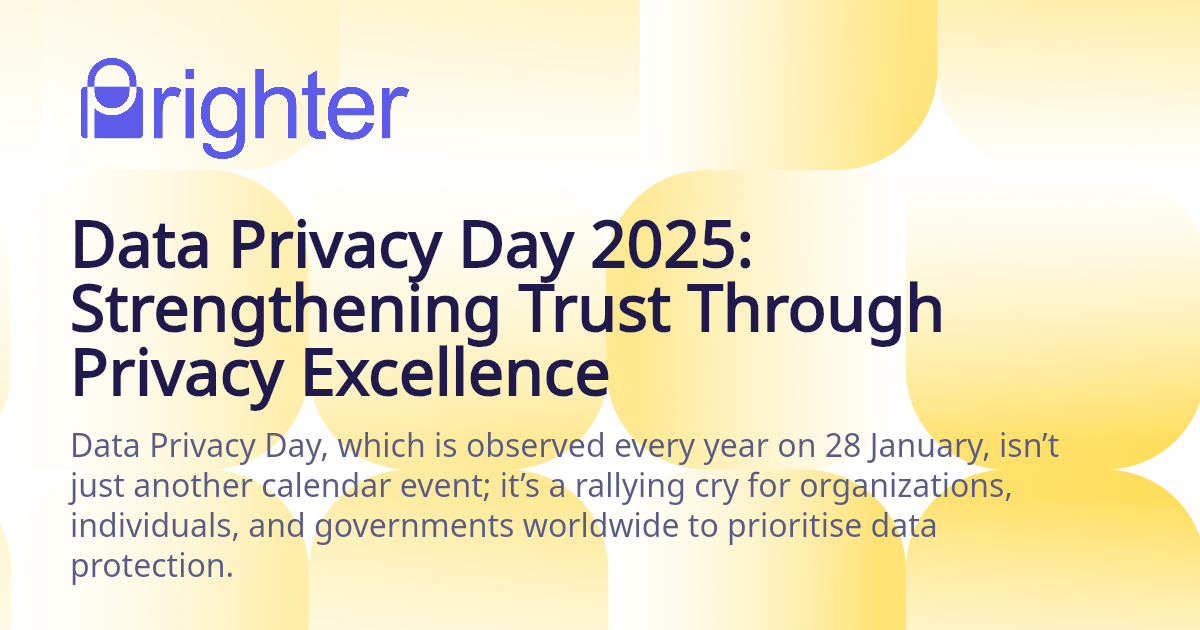
Data Privacy Day 2025: Strengthening Trust Through Privacy Excellence

Data Privacy Day, which is observed every year on 28 January, isn’t just another calendar event; it’s a rallying cry for organizations, individuals, and governments worldwide to prioritise data protection.
With over 47 countries participating, this international day underscores the critical importance of safeguarding personal information amidst evolving challenges in the digital age.
For businesses navigating complex privacy regulations, this day is an opportunity to reflect on your compliance strategies and renew your commitment to ethical data practices.
Whether you’re tackling data protection requirements under the GDPR, the CCPA, or any other privacy regulation, managing data subject requests, navigating international data transfers, or you’re simply future-proofing your operations, strong privacy frameworks are no longer optional — they’re essential.
The business case for robust data privacy
Given the current geopolitical climate, including the incoming Trump administration considering changes that call the validity of the DPF into question, it’s never been more necessary to take a proactive approach to your data protection and privacy processes.
There are a few reasons why businesses should prioritise the implementation and maintenance of a robust privacy programme, beyond ethical responsibilities. These include:
1. Strengthening trust with stakeholders
In an era where data breaches dominate headlines, consumers are more aware of privacy issues than ever before. Trust has become a competitive advantage, and companies that can demonstrate robust privacy practices stand out.
Making a firm commitment to strong data privacy practices not only ensures your business can manage risks and avoid potential liabilities, but it also sends a powerful message to your customers, partners, and investors.
In B2B transactions, recipients have firm expectations that their service providers are compliant with applicable laws and regulations. Failure to demonstrate appropriate compliance measures can unnecessarily lengthen sales cycles and jeopardises potential customer and partner relationships.
2. Keeping ahead of regulatory changes
Privacy regulations are in constant motion, with new laws emerging that can significantly impact international businesses. Staying ahead of these changes offers not just a compliance benefit but also a commercial advantage. By anticipating what’s coming and embedding it into your data privacy strategy now, your organisation can avoid costly last-minute adjustments and wasted resources down the line.
For global organisations, a forward-thinking approach means closely monitoring legislation that may affect the business’s data protection program. Such horizon-scanning should look beyond data protection laws to broader digital governance regulations.
This is likely to include global laws governing the development of AI technologies and obligations relating to online safety for those offering intermediary, hosting or online platform services including the Digital Services Act (DSA) and UK Online Safety Act (OSA). Being prepared for upcoming regulatory changes allows your organisation to align with evolving expectations and avoid disruptions.
Proactively integrating these considerations into your privacy measures demonstrates a commitment to not only compliance but also operational efficiency. It ensures that your organisation is ready to adapt, saving time, reducing risk, and maintaining trust with stakeholders.
Partnering with Prighter gives you the expertise and tools to monitor global regulatory changes, evaluate their impact on your organisation, and implement effective, future-ready solutions.
3. Fostering a culture of accountability
Privacy isn’t just a legal or IT issue; it’s a company-wide responsibility. Data Privacy Day is an opportunity to engage employees, educate them on best practices, and embed privacy into your organizational DNA.
By taking this approach, you can reduce risks such as employee human error, much of which is avoidable through regular training and ensure relevant teams have plans to follow and know how to respond if and when an incident occurs. You can also increase the strength of your overall approach to data protection and privacy.
3 steps to begin advancing your approach to privacy
While privacy compliance can seem complex and at times insurmountable, there are proactive measures that businesses can take in order to improve your approach:
Step 1: Ensure the foundations are strong
Begin by understanding the status quo of your organization’s approach to data privacy and updating policies and procedures as part of an ongoing process. This includes:
- Evaluating your activities: Regularly evaluating and documenting your organization’s processing activities, including the geographical scope of your activities to identify and assess the risk profile of the data it processes.
- Reviewing laws: Reviewing the laws of any relevant jurisdictions and considering the requirements of any appliable extra-territorial scope, including the need to appoint a Representative (for example in the EU, UK, Turkey, Switzerland and China).
- Assessing high risk activities: Assessing any identified higher risk processing activities including processing data of vulnerable individuals (e.g. children, employees, etc) and establishing necessary safeguards.
- Meeting transparency obligations: Meeting applicable transparency obligations by jurisdiction, including implementing or updating privacy policies as necessary.
- Reflecting individual’s rights: Ensuring your processes reflect individual's rights by jurisdiction
- Choosing an approach: Deciding on the best approach to your global privacy program – whether to harmonise competing laws or operate different approaches by region.
Prighter can help here, providing you with the insights and expertise that your business needs to understand the full extent of your obligations, and to ensure that you have the correct processes and practices in place to maintain compliance.
Step 2: Enhance transparency and give genuine choice
Transparency has long been a common cornerstone of data protection legislation. When individuals clearly understand how their data is collected, used, and shared, they feel more in control, which fosters confidence in your organization. Providing information in a format that is comprehensive yet easy to read and understand can prove difficult for companies operating globally and having to cater for multiple, competing data protection regimes in one document.
Using a layered approach with clear signposting within the document can help. Where products or services may be used by children, special consideration should be given to the age of consumers and the best way to present information, including incorporating icons or using video formats.
Transparency is also an important factor to impress upon other teams within the organization including developer teams, for example when considering the UI of web pages. Inadvertently or subconsciously incorporating dark patterns can be easy to do, especially where such patterns have become commonly used within the organization's practices.
When considering the lawful basis for any processing activity, it is important to identify the most appropriate basis. If evaluating whether to rely on consent, businesses should carefully consider whether the individual has a genuine choice over the use of their data and the implications for your organization if consent is withdrawn further down the line. Consent may not be appropriate where there is an imbalance of power between your organization as controller and the data subject.
Ensure any consent mechanisms meet the requirement of applicable legislation, for example that the individual giving consent is fully aware of the way in which their data will be used, their consent is explicit and is given of their own free will. This may mean having to review the methods by which you are obtaining consent and ensuring sufficient granularity for specific types of processing.
Consult with privacy experts to evaluate whether your approach could be more transparent and user focused. For instance, integrating real-time consent dashboards or offering visual data mapping tools can help individuals better understand how their data flows through your organisation. By adopting these practices, you demonstrate not only compliance but also a genuine commitment to respecting user privacy.
Step 3: Be ready and able to respond to individual’s requests
Ensuring individuals have the capacity and means to exercise their rights and that your organization has an effective and timely system to respond, is a key part of any data protection program.
Any business that has had to deal with a data subject access request for example is likely to know the significant amount of time and resource that dealing with such requests can require. Handling data subject requests (DSRs) within the short regulatory timeframes permitted requires proactive planning and the advance implementation of reliable, efficient systems.
On this journey, you should use tools and services that help to centralize your privacy management efforts, which may include software designed to simplify the process of managing, tracking and handling DSRs across multiple jurisdictions. This not only ensures consistency but also frees up your team to focus on strategic privacy initiatives.
Partnering with Prighter provides the perfect combination of legal expertise and cutting-edge technology to support your efforts. Our platform streamlines compliance with features like automated DSR handling, integrated processing activity registers, and privacy representation services.
With Prighter, you can not only meet regulatory requirements but also build an adaptable, future-proof compliance framework that supports your organisation’s growth and resilience in a rapidly changing privacy landscape.
Looking ahead: Data privacy in 2025 and beyond
Data privacy compliance means not only meeting today’s challenges but anticipating tomorrow’s.
Prighter supports businesses globally in navigating these complexities, ensuring privacy compliance is a cornerstone of their strategy.
Celebrate Data Privacy Day by reaffirming your organization’s commitment to responsible data handling. Book a free consultation with our experts today and explore how we can help future-proof your compliance efforts.









